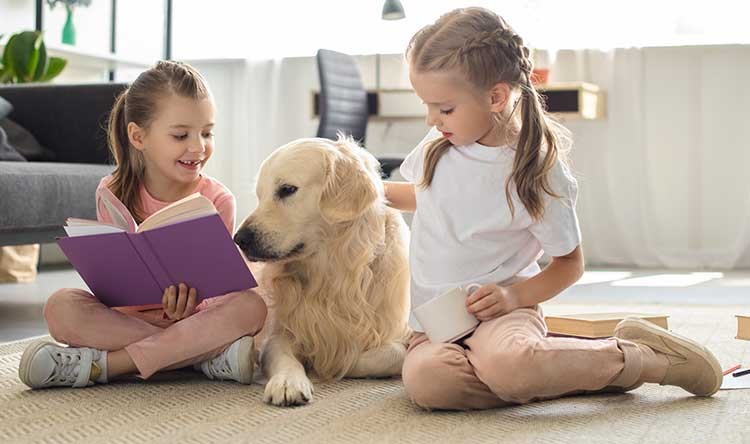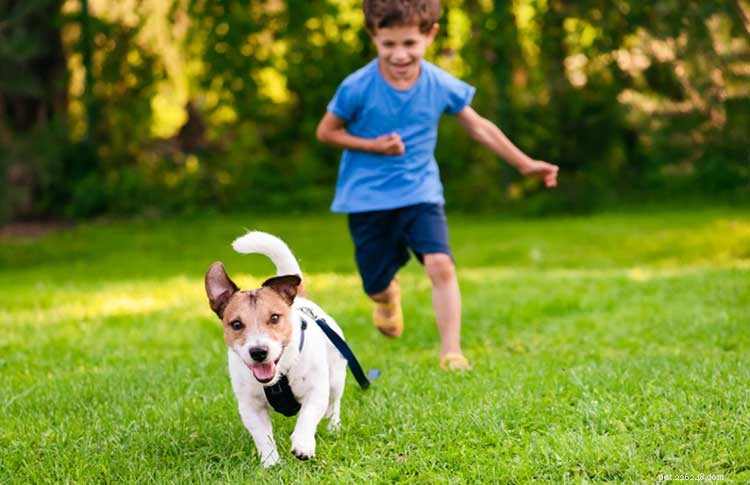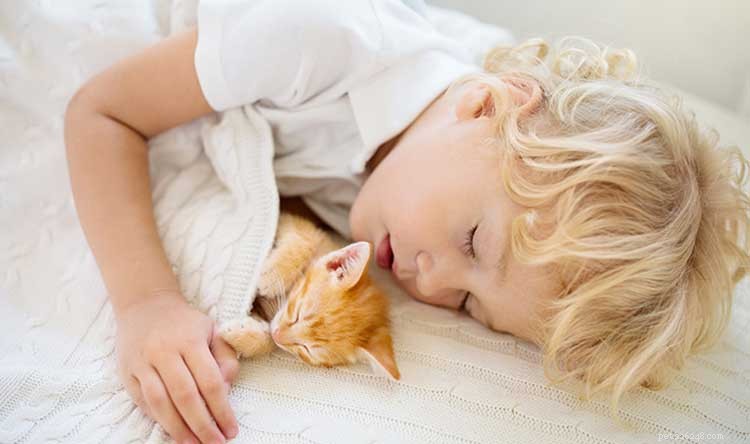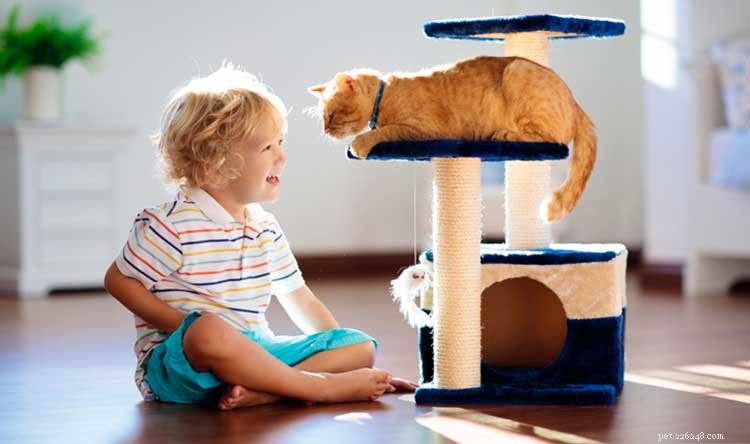Apresentando animais de estimação e crianças:dicas de um treinador
Principais conclusões
- As crianças se beneficiam muito de ter um animal de estimação, mas é essencial escolher o tipo certo de animal de estimação e apresentá-lo adequadamente.
- A escolha de ter um cachorro ou um gato dependerá do nível de energia da sua família e de quanto tempo você tem para cuidar de um animal de estimação.
- Seja qual for o animal de estimação, a chave é preparar sua família com antecedência e fazer as apresentações devagar e com cuidado.

Então, seus filhos têm idade suficiente para desfrutar de um animal de estimação por perto e estão implorando por um .
Você deve ter um cachorro ou um gato? Como você mantém as crianças seguras? Como você ensina a eles a responsabilidade de possuir um animal de estimação?
Pedimos conselhos a Sarah-Anne Reed, treinadora holística de cães e proprietária da Pack Dynamics LLC.
Como posso saber se meu filho está pronto para ter um cachorro?
Seu filho deve ter idade suficiente para entender e seguir as instruções sobre como interagir e cuidar de seu cão. Se eles não estiverem de acordo com o treinamento e seguindo suas dicas, a inconsistência pode causar muita ansiedade para você, resultando em problemas comportamentais.
Se o seu filho ainda está tendo colapsos extremos, como chutar, gritar, bater ou jogar coisas, este não é um ambiente confortável e seguro para trazer um cachorro e pode fazer com que ele fique com medo. Quando os cães estão com medo, eles provavelmente rosnam ou mordem a pessoa de quem estão com medo, e isso pode facilmente levar a uma mordida no seu filho. Isso não significa que o cão seja agressivo, apenas que ele precisa estar em uma casa sem filhos.
Seu filho está pronto para ter um cachorro se:
- Pode ouvir e seguir instruções.
- Saiba como expressar ansiedade ou raiva de maneira saudável, sem gritar ou bater.
- Demonstraram que podem ser gentis, gentis e amorosos com os animais.
- Tenha uma compreensão realista do que significa cuidar de um cachorro.
Como posso saber se meu filho está pronto para ter um gato?
Os gatos são muito menos responsáveis por uma criança. Eles não precisam ser caminhados ou treinados e são bastante autossuficientes. Um gato pode ser um ótimo amigo de infância, principalmente se for carinhoso e gostar de se aconchegar no seu colo. Um gato pode ser o animal de estimação perfeito para crianças pequenas para ajudar a ensinar-lhes responsabilidades, como alimentar seu gato, escová-lo e limpar sua caixa de areia.
É também uma excelente oportunidade para ensinar ao seu filho a forma adequada de dar carinho a um animal. Ensiná-los a não puxar o rabo, a acariciá-los bem, a falar com eles com gentileza e sempre mostrar amor. É vital garantir que você escolha o temperamento certo ao adquirir um gato, porque nem todos os gatos gostam de carinho ou se sentem à vontade com crianças. Passe algum tempo com o gato antes de tomar a decisão de trazer para casa um novo membro da família.
Quais são as diferenças entre apresentar um cachorro ou um gato ao meu filho?
Apresentando gatos para crianças
Introduzir um gato em sua casa é um processo muito mais fácil do que um cachorro. Quanto mais calmo for o ambiente, mais confortável será para o seu novo animal de estimação se adaptar à sua nova casa e família. Ao apresentar um gato, primeiro deixe-o explorar lentamente sua nova casa e mostre a caixa de areia. Mudar para gatos pode ser difícil e criar curiosidade e, às vezes, medo, e é por isso que é crucial apresentá-los lentamente aos membros da família. As crianças podem ser difíceis para os animais porque são menores, seus movimentos são mais imprevisíveis e soam e se comportam de maneira diferente dos adultos.
Quando um gato fica com medo, ele pode assobiar ou arranhar, o que pode ser assustador para uma criança. Eles também podem recorrer ao esconderijo. Nenhuma das reações cria uma experiência feliz para o seu gato ou filho.
Certifique-se de que sua família esteja relaxada e apresente lentamente o gato a cada membro da família, um de cada vez. Peça ao seu filho para chamar o gatinho e primeiro deixe o gato cheirar a mão dele, depois ofereça alguns petiscos. Se o gato se aproximar e parecer confortável com seu filho, peça-lhe para tocá-lo suavemente, enquanto você orienta e encoraja.
Dicas:
- É melhor ter várias interações curtas com seu gato para não pressioná-lo demais.
- Não force nenhuma interação. Se o seu gato não quer ser tocado ou tocado, respeite que ele pode precisar de mais tempo para se acomodar.
- Dê pequenos passos até criar uma experiência confortável para o gato e seu filho.
Apresentando cães a crianças
Apresentar um cão ao seu filho pode ser muito mais envolvente. Before ever deciding to get a puppy or adopt a dog, always have your child meet the dog first to see how they interact with each other. If you are thinking of adopting a dog, many dogs have had bad experiences with children or adults in their past, which can cause them to be wary and nervous with children and people in general. I do not recommend adopting a dog who shows any anxiety or fear with your child, as it can take months or even years to help a dog overcome fear, no matter how kind your child is.
Once you have determined that the puppy or rescue dog will be a good match for your family and lifestyle, it’s a good idea to bring something familiar into your home to help them adjust. You can bring their dog bed, a blanket, and toys that will be comforting to them. Set up everything for your dog so that they start to learn where their water bowl is and can go to their familiar dog bed or grab their toy if they need some familiar comforts.

The introduction step-by-step:
- The best way to introduce a dog to your child is to sit them in a chair beside you as the dog is walked into the room by another adult with a slack leash. It’s vital that the dog and child be as calm as possible before they meet giving them the best opportunity for success.If the dog walks ahead of the person on leash, the handler turns around to walk in the opposite direction a few steps, then waits 30 seconds before walking back into the room.
- Repeat bringing the dog in until he is calmly walking beside the person without any eye contact or talking as they are being walked into the room. Be sure no one is looking at the dog or talking to them, to help the dog feel relaxed, with no pressure.
- The person holding the leash sits in a chair across the room from the child, and everyone continues ignoring the dog until he settles down and stops trying to get everyone’s attention. Once the dog has been calm for five minutes, you can drop the leash, and then the child can call the dog over for affection in a relaxed, friendly tone. Be sure the child is sitting with their body facing away from the dog, so as not to loom over them when they approach for attention and offer a treat, with the palm of their hand facing up.
- Once the dog feels comfortable accepting the treat, the child can reach down with one hand and slowly pet them on their chest first, never over their head, as that can make a dog feel uncomfortable. If the dog appears to feel safe and relaxed, they can rub the back, rump, and tummy.
Taking these additional steps will help your dog learn how to calmly interact with your child and teach your child to be kind and gentle to your dog. Your dog has emotions too and can feel nervous or uncomfortable. It’s wise to keep the leash attached to the dog for a while, just in case you misjudged their reaction, you can easily remove the dog from the room if you need to.

What can I do to prepare my child ahead of adopting a dog or cat?
Discussing the responsibilities
Talk to your children before adopting a dog or cat and explain the additional help you will need from them. Your children should feel included in the process and understand that this is a life-long commitment.
Take a “trial run” by pet sitting
It’s a great idea to dog sit for at least a week for a friend or family member to give a real-life experience to your child about the reality of having a dog. Include them in feeding the dog, teaching them how to brush the dog, give affection and play appropriately and take your child along during walks.
Playing with a dog sounds fun, but are they willing to help take the dog out to eliminate, and do the necessary “poop patrol,” even when it’s a cold or a rainy day?
You can also cat-sit if you are planning on getting a kitty to teach your child about the responsibilities of having a cat, like cleaning the litter box, feeding, and brushing them. It’s also essential to teach them how to appropriately play with and give affection to the cat. If you don’t know anyone you can dog- or cat-sit for you could foster for a week. This not only gives you a tremendous real-life experience and also allows you to see if the pet is a good fit for your family and lifestyle.
Is there any other advice you could give to parents wanting to bring a dog or cat into the household?
If you feel like you are already juggling too much in your life, know that having a dog often feels like having another child. Dogs have different needs than children, but if you don’t have the time and patience to dedicate to training and their care as a family, it’s not a good idea to bring a dog into your home as you will feel even more overwhelmed. A cat may be a better option for busy parents, as they require much less time and attention and don’t need training, but still allow your child to learn about the responsibility and joys of caring for and loving an animal.
I do not recommend asking your children to walk your new puppy or dog until you have mastered heel training. Most adults have difficulty walking an untrained dog and a child could easily get hurt, or the dog could get loose and run away or get injured. Once your dog knows how to heel it’s advisable that you walk your dog with your child for a while until your child feels confident and you trust your child to handle every situation that may happen during a typical walk. If your dog reacts to other dogs, either wanting to play with them or nervous when they see another dog, this can be too much to handle for most children, depending on their age.
Sarah-Anne Reed is a holistic dog trainer, and owner of Pack Dynamics, LLC ®. Her practice focuses on understanding and respecting dogs as a different species and honoring them as individual beings.
This article is copyrighted by Sarah-Anne Reed and Pack Dynamics ® LLC, and no reproduction of this article without the express permission of Sarah-Anne Reed is permitted.
Are you thinking about getting a new pet? Then you are a great candidate for pet insurance. Get a quote and make sure you’re covered for future injuries or illnesses.
- Principais dicas sobre como apresentar seu novo gatinho aos seus animais de estimação atuais
- Seis dicas de treinamento da perspectiva de um cão
- Dicas sobre como apresentar um novo cão
- 5 dicas para apresentar um novo filhote ao seu cão
- Dicas do instrutor:“Deixe isso”
- Dicas do instrutor:como parar de puxar a trela
- Dicas do treinador:exercícios de foco para passear com cães adultos


